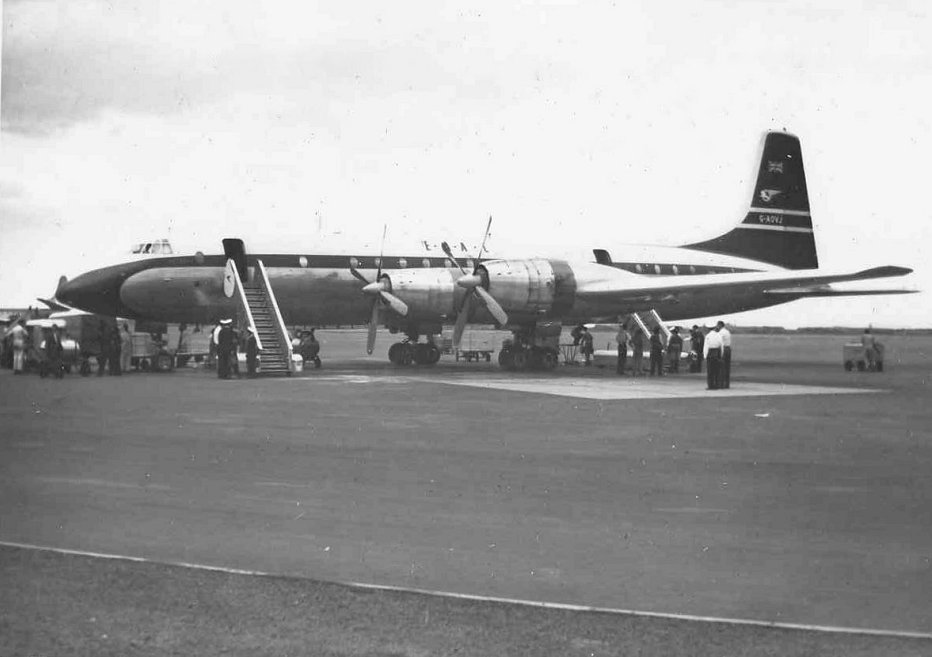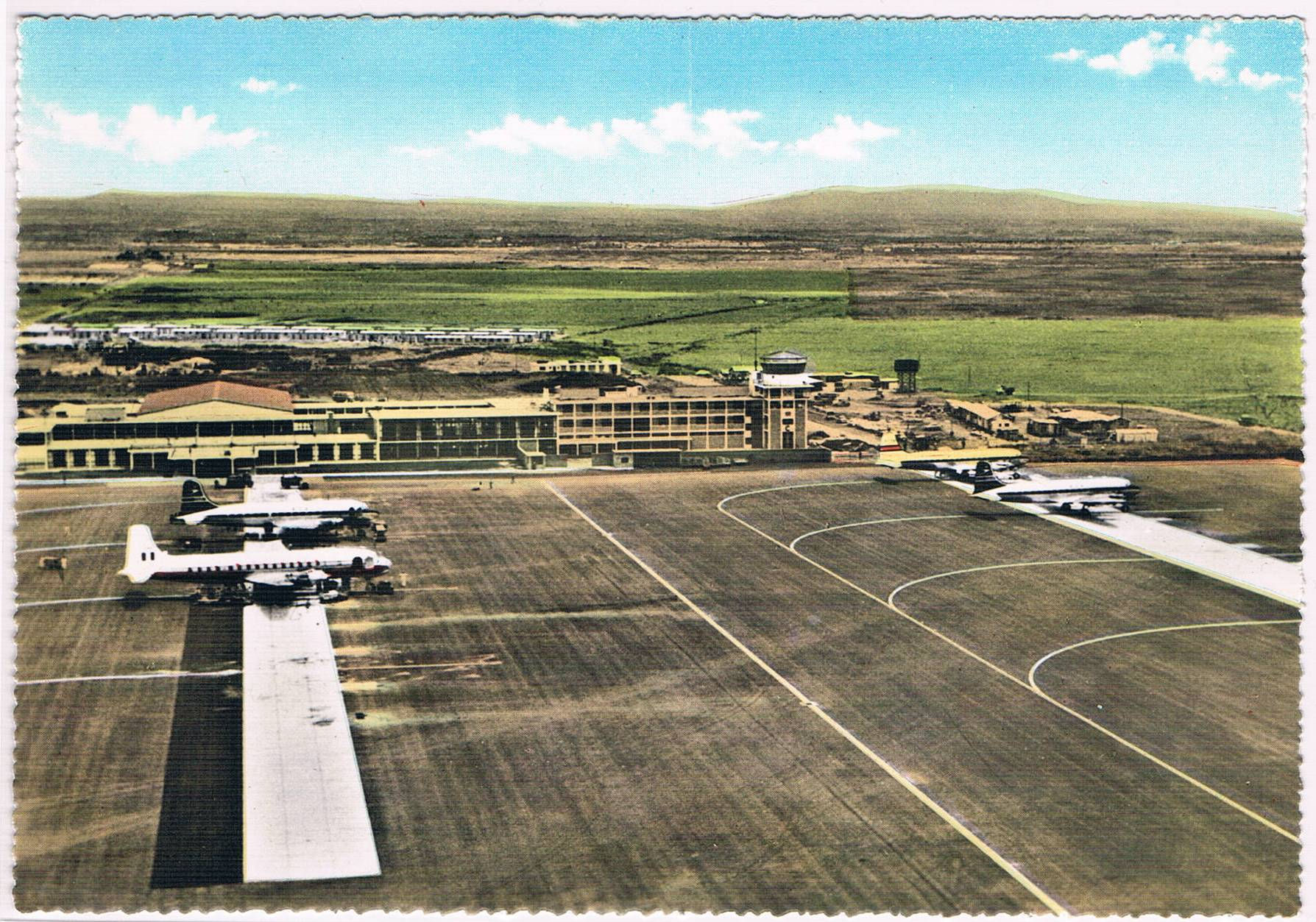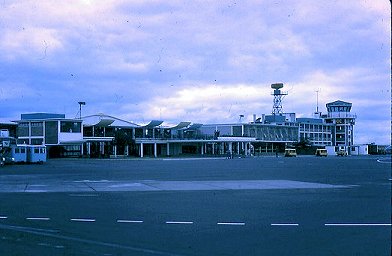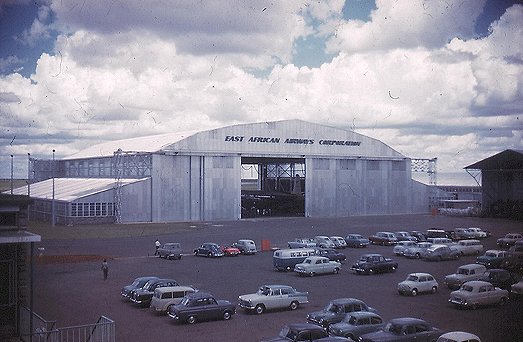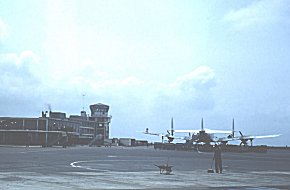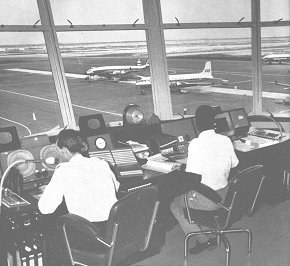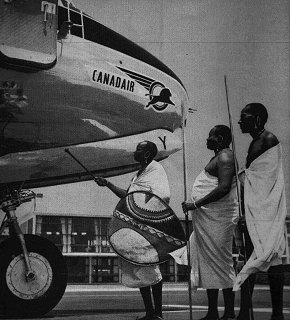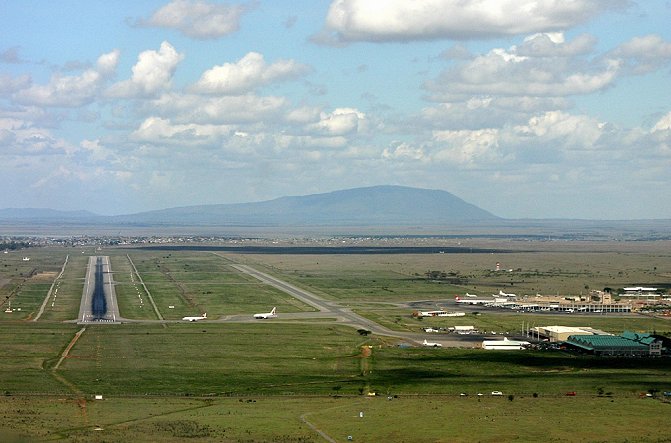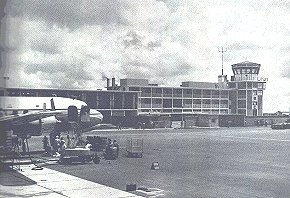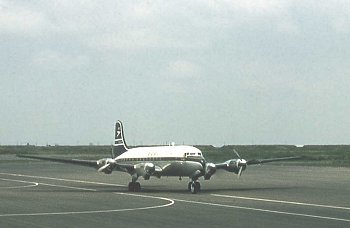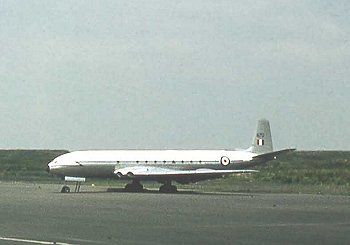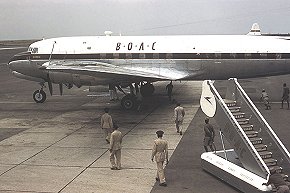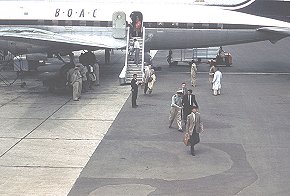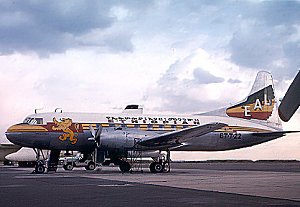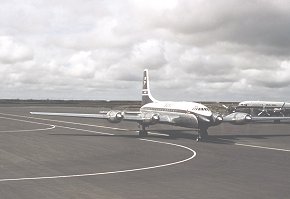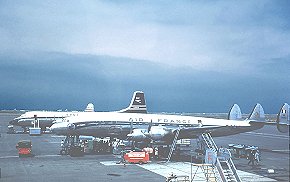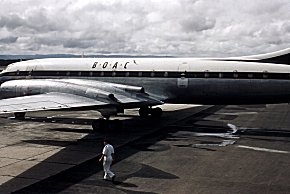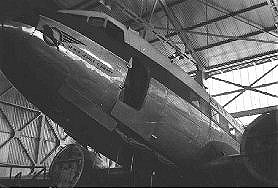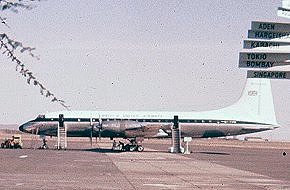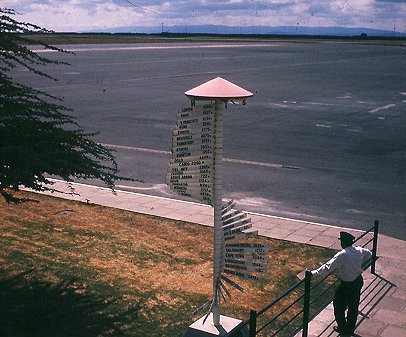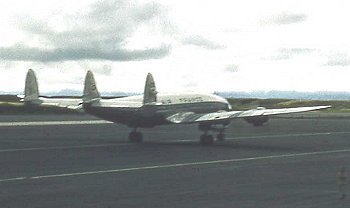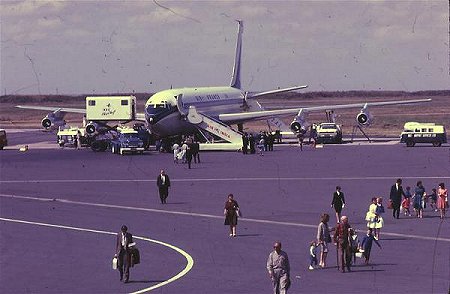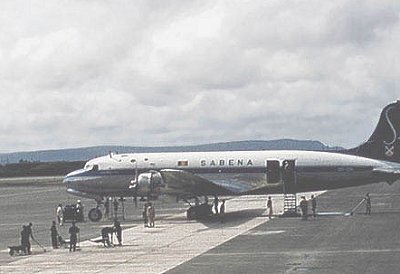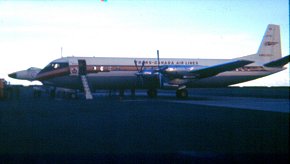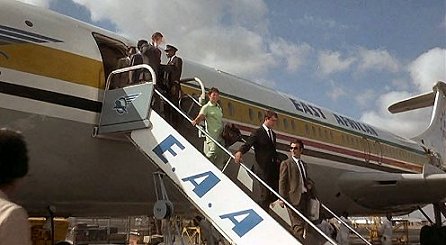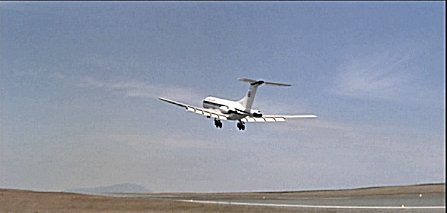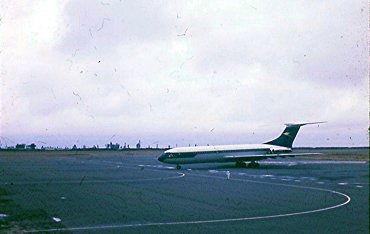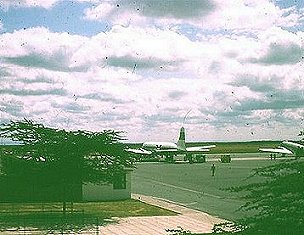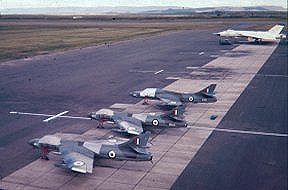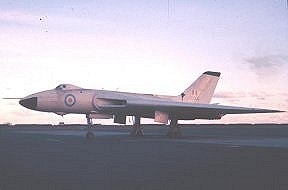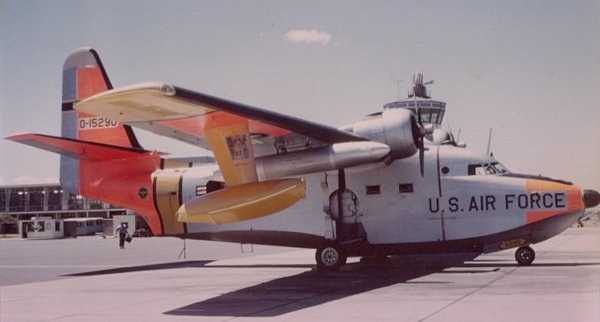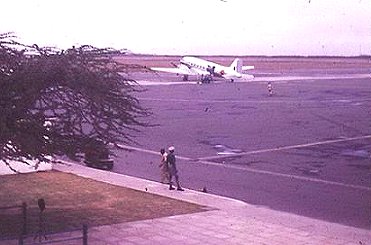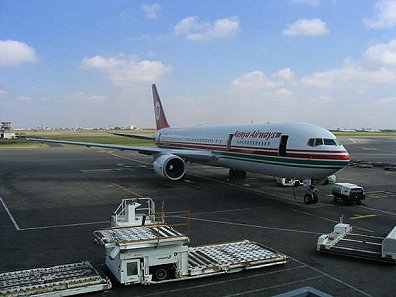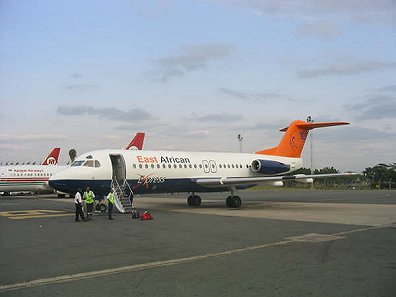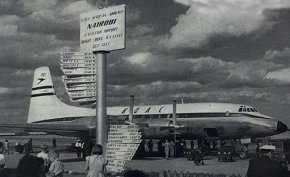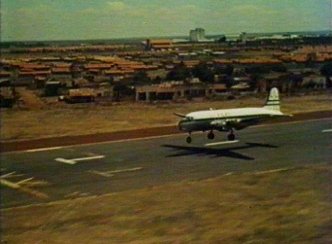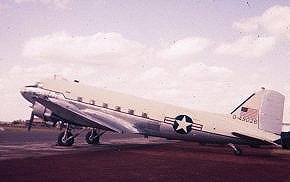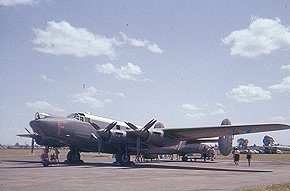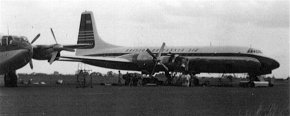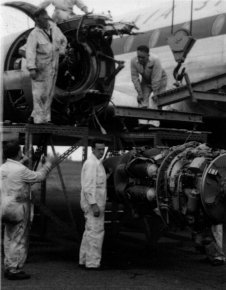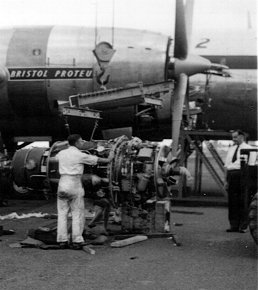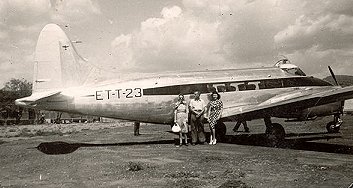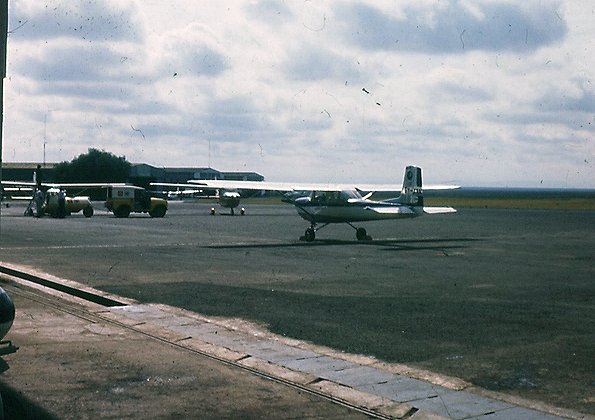|
Nairobi Embakasi |
|||
|
Nairobi Embakasi was opened in May 1958 by the Governor. The Queen Mother was unable to undertake the official opening owing to her QANTAS Constellation being delayed due to engine trouble. The Queen Mother had been on an official visit to Australia. |
|||
|
|
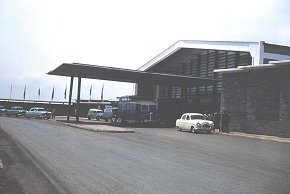 |
||
|
Embakasi's austere entrance (left) taken shortly after the airport opened in 1958. Another view (right) of the entrance featuring the East African Airways half decker coach which ferried passengers to and from Nairobi Note also the Ford Zephyr Mk 1, the Peugeot 202 estate car and the Mark 2 Ford Zephyrs in the background - PHOTOs (left) Malcolm McCrow and (right) Ron Bullock |
|||
|
|
|||
| In the days before South African Airways/Suid Afrikaanse Lugdiens introduced the first Boeing 707 service through Nairobi in 1960, an SAL DC7B waits on the apron at Embakasi - PHOTO the late Jim and Hilda Dixon It is interesting to note that the BOAC Britannia has been recently leased, probably most likely to East African Airways as there is clearly visible a painted out patch below the BOAC Speedbird on the fin. | |||
|
|
|||
| East African Airways Britannia 312 G-AOVJ on lease from BOAC. In this case the BOAC has been easily altered to read EAAC and the Speedbird has been painted out and the East African Airways flying lion substituted - PHOTO the late Jim and Hilda Dixon | |||
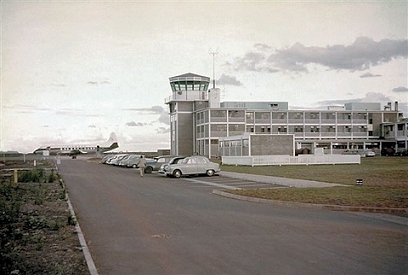 |
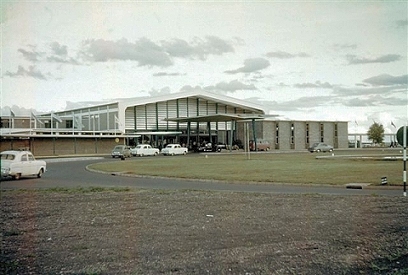 |
||
|
Nairobi Embakasi around 1959.
An Airwork Viscount 800 stands on the apron beyond the tower (left);
another view of the entrance to the Terminal Building (right) - PHOTOs Daphne Seager
|
|||
| Contmporary postcard showing Embakasi shortly after its opening in 1958. Two BOAC Argonauts sporting the ble tailfin adopted in that year are joined on the apron by an Alitalia DC6B. | |||
|
|
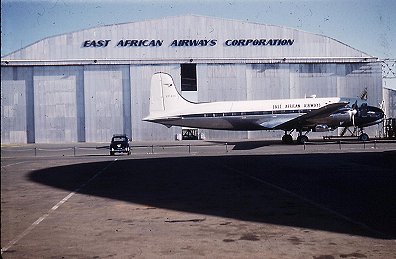 |
||
| Nairobi Terminal Buildings and Tower taken from a deserted apron (left). The observation platform is centre picture and the airport restaurant is to the right of it. The East African Airways' Hangar (right) with one of the Canadair 4 Argonauts ( VP-KOI) accompanied by an MG Magnette - PHOTOs - Ron Leese | |||
|
|
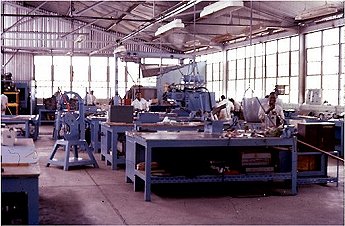 |
||
| A fine line up of classic 1950scars (left) taken after the introduction of the Comet 4 in 1961. (A Comet is just discernable in the hangar.) East African Airways airframe shop at Embakasi (right). PHOTOs - Ron Leese | |||
|
|
|
||
|
The control tower (left) taken from the observation platform. Air France Super G Constellation (right) on the apron while a workman attends to the tarmac with a broom and wheelbarrow. PHOTOs (left) Malcolm McCrow and (right) Ron Bullock |
|||
|
|
|
||
|
Embakasi Control Tower with Air India Super Constellation, SAS DC6B and East African Airways Canadair Argonaut visible through the windows. Massai men pose by an East African Airways Argonaut. Both photographs from Nairobi - City in the Sun (1961) |
|||
|
|
|||
|
On finals for Rwy 06 on 14 November 2004. Air Mauritius A319 and Air India A310 is holding short. The terminal is now the right, but the runway is still the original built at Embakasi in 1957-8. Ol Donyo Sabuk dominates the skyline to the east. PHOTO - Hannes Meyer |
|||
|
|
. 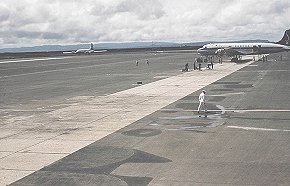 |
||
| Another image from Nairobi - City in the Sun which shows the terminal building at Embakasi Airport around 1959 (left) - before Alitalia introduced its DC8 jetliners to replace the DC7 service through Nairobi. Classic Embakasi - a BOAC Britannia 312 taxies in from Runway 06 to share the apron with a Sabena DC-6 - PHOTOs (left) Malcolm McCrow and (right) Ron Bullock | |||
|
|
|
||
|
BOAC's daily Argonaut Flight BA 161 taxies in on its inboard engines during 1958 (left). Prior to 1958, the tail fin would have been white, and during 1958 the Argonaut was withdrawn by BOAC and replaced by the Britannia. An RAF Transport Command Comet 2E is parked on the apron (right). PHOTOS - Ron Bullock |
|||
|
|
|
||
| Ron Bullock's 1957 shots of the the daily BOAC Argonaut flight BA 161 arriving from London, Rome, Benghazi, Khartoum and Entebbe. Before the Suez crisis this flight operated through Cairo. | |||
|
|
|
||
|
In the late 1950s, an Ethiopian Airways Convair 220 could usually be found at Embakasi. In this photograph (left) by Brian Robbins, a Valiant V-bomber can just be discerned behind the Convair. Britannia 312 G-AOVE taxies in to the stand past East African Airways Canadair Argonaut. PHOTO (right) - Ron Bullock. In 1959 BOAC operated the trans-Atlantic 312 Britannias to South and East Africa after they had been displaced on the London to New York service by (for a short time) the Comet 4 and then the Boeing 707. |
|||
|
|
|
||
|
Photographs from Ron Bullock of an Air France Super 'G' Constellation, a BOAC Britannia 312 and East African Airways Canadair Argonaut. By 1960 BOAC had reverted to its original plan and used the Britannia 102 on Flight BA 161 to Nairobi via Rome, Khartoum and Entebbe. |
|||
|
|
|
||
| C47B undergoing maintenance in East African Airways' Hangar (left). Embakasi's modern sign that replaced the original East African Airways sign at Eastleigh. A British United Britannia 313 is on the apron (right). PHOTOs Malcolm McCrow | |||
|
|
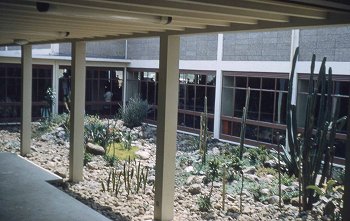 |
||
| A deserted apron viewed from the observation platform (left) and the rock garden by the departure gate (right) - PHOTOs (left) Ron Leese (right) Ron Bullock | |||
|
|
|
||
|
Air France - 10 years apart. An Air France Super G Constellation (left) taxies for Runway 06. PHOTO - Ron Bullock. By the 1960s Air France is operating the Boeing 707 through Nairobi (right) - but never mind whose steps are used - Air India for'ad and BOAC aft. PHOTOs - Ron Leese |
|||
|
|
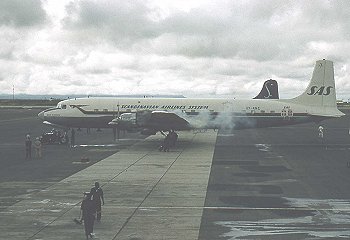 |
||
|
Sabena - Belgian National Airlines, now sadly defunct - actually operated its major route network in what was then the Belgian Congo where most of its fleet was based. Here (above left) one of its DC6Bs prepares for departure from Embakasi to Entebbe and Leopoldville (Kinshasa). A Scandanavian Airlines System DC-7C (above right) blasts its exhaust across the apron in a characteristic piston engine start-up (right). Behind the DC-7C is a SABENA (Belgian Airlines) DC-6B which will depart for Entebbe and [the then] Belgian Congo. PHOTOs - Ron Bullock |
|||
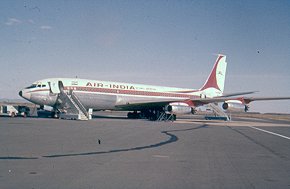 |
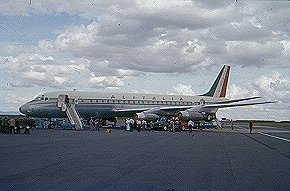 |
||
|
Air India introduced the Boeing 707 (left) and Alitalia the DC-8 (right) to Nairobi in 1961. In December 1960 South African Airways ran one of their Boeing 707s off the runway without serious damage to the aircraft or passengers. BOAC had a narrow escape with a Comet 4 which literally touched the ground in the game park on finals - only the Captain's pride was seriously dented. PHOTOs Malcolm McCrow |
|||
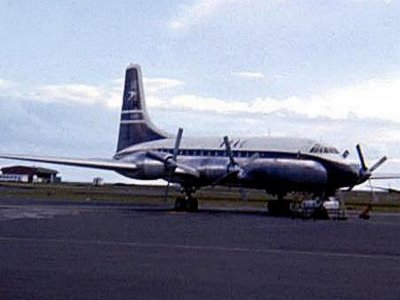 |
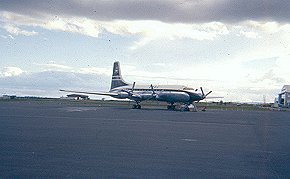 |
||
|
BOAC Britannia 102 occupies its usual stand for the 2010 departure of Flight BA 162 to Entebbe, Khartoum, Rome and London. The building on the left is the airport fire station. PHOTOs Malcolm McCrow |
|||
|
|
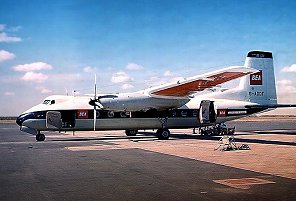 |
||
| Trans Canada Airlines Vickers Vanguard (right). The Vanguard was on hot and high test flights and arrived just before sunset. With Nairobi being 5500 ft above sea level, it was not uncommon to see new aircraft types in liveries of airlines which never visited Nairobi in scheduled service. A Handley Page Herald in BEA (British European Airways) livery on a similar visit - PHOTOs (left) Malcolm McCrow (right) Brian Robbins | |||
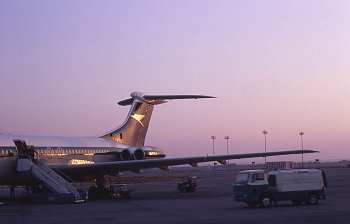 |
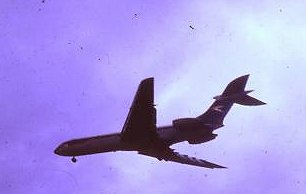 |
||
| The morning sun catches the fin and wing fence of a BOAC VC10 (right). PHOTO - Ron Bullock A BOAC VC10 departs 06 (right) - PHOTO Ron Leese. While BOAC operated standard VC10s through Nairobi, East African Airways operated the Super VC10. | |||
 |
An East African Airways Comet 4 on
finals for Runway 06 (left). By the late 60s the Comets had begun to
replace the Canadairs on the Inter City flights between Nairobi and Dar-es-Salaam
or Entebbe. PHOTO Ron Leese
|
||
|
|
|||
| East African Airways Super VC10 on the Apron at Embakasi - PHOTO - Columbia - film - Living Free | |||
|
|
|||
|
A British United VC10 (above) rotates and climbs away from Runway 06 in 1967. Note Ol Donya Sabuk . PHOTO - Columbia - Film "Born Free" |
|||
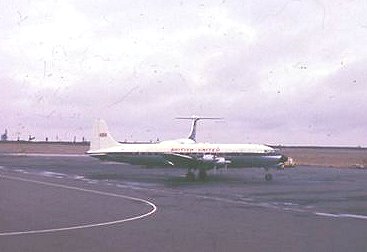 |
A British United DC-6B Freighter (left) arrives Nairobi, possibly from the South. Once or twice a week these freighters operated the "Animal Special" to London Heathrow. By 1963 a great number of ex-patriots were sending their pets to the UK in the run up to Uganda's independence and crates containing cats and dogs would arrive from Entebbe in the cargo hold of BUA's scheduled Britannia flights. After a few hours stay in Nairobi the domestic pets joined wild animals for the flight to London where the wild animals were despatched to UK zoos and other zoos throughout Europe and the world. These animal specials had cabin crew who tended to the animals in flight. By the mid 1960s the VC-10 (right) was in service with the three major airlines operating through Nairobi - BOAC, BUA and East African Airways, but only the latter operated the Super VC-10. PHOTO - Ron Leese |
||
|
|
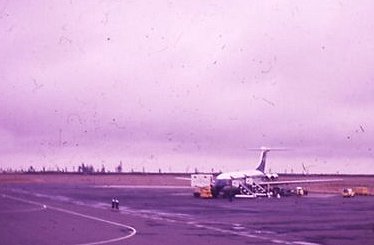 |
||
| A BOAC VC10 (right) begins to taxi for Embakasi's Runway 06. PHOTOs - Ron Leese | |||
|
|
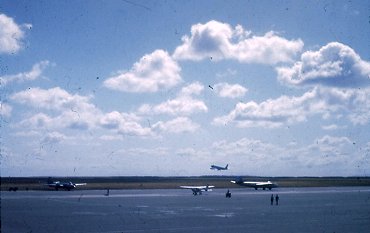 |
||
| A typical day at Embakasi (left) with an unidentified DC-6 and C47B on the apron. Note the thorn trees. Under a typical Nairobi afternoon skyscape a Boeing 707 climbs out from Runway 06 while two UK Air Force Canberra bombers prepare for departure. A Cessna 150 will be left as sole occupant of the apron - PHOTO (left) - Ron Leese. | |||
|
|
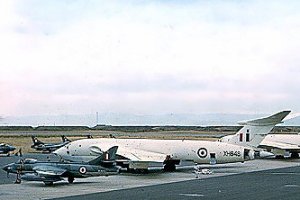 |
||
| Two Hawker Hunter FGA9s (nearest) and a T7 (farthest) (left) share a deserted apron with an Avro Vulcan (right). On another occasion (right), Victors and Hunters crowd the western end of the apron. PHOTOs (left) Malcolm McCrow and (right) Brian Robbins. The RAF had contingency plans to operate fully laden V-bombers out of both Embakasi and Entebbe. | |||
|
|
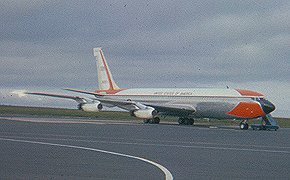 |
||
| A Vulcan at sunset (left), about to be joined by the TCA Vanguard. With a full bomb load and full tanks, a Vulcan would have required more than 9500 ft of Embakasi's 10 000 ft runway to get airborne. 8 December 1961 - my last visit to Embakasi. Early morning arrival of a USAF Boeing 707. PHOTOs Malcolm McCrow | |||
|
|
|||
|
This SA-16 of the 58th Air Rescue Squadron was based at Wheelus AB, Tripoli
Libya from Mar 1961 until Sept 1962. It was also seen at Entebbe in the
week or so before Independence, 9 October
- PHOTO Hal Maynard
|
|||
|
|
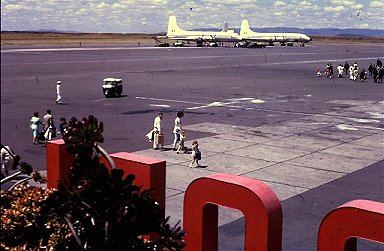 |
||
| A C47B of the Ethiopian Air Force at Embakasi - possibly the same aircraft that appears on the Entebbe page. An Argosy transport of the UK Air Force is towed across the apron at Embakasi past a Boeing 707 of Lufthansa. Two UK Air Force Britannias occupy stands often used by the Royal Air Force when visiting Embakasi. PHOTOs - Ron Leese | |||
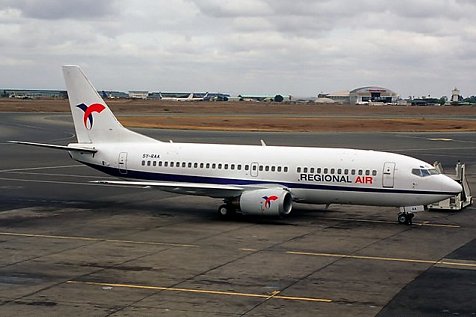 |
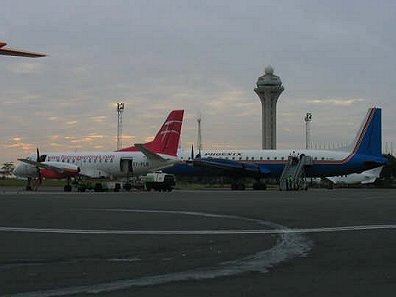 |
||
| On October 31 2000, Boeing 737-3 (5Y RAA) of Kenya based British Airways subsidiary Regional Air on the apron of present day Jomo Kenyatta International (south of runway 06/24) with the old East African Airways hangar of Embakasi dominating the background - PHOTO (right) Christian Hanuise. Flamingo Saab 340 shares the apron with a Phoenix Ilyshin IL 18 (left) - PHOTO Daniel Amtmann | |||
|
|
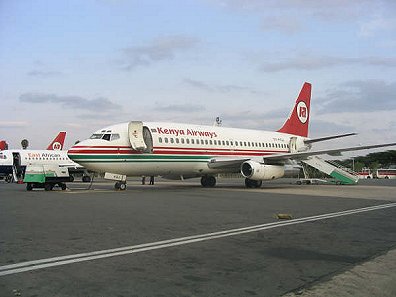 |
||
| Kenya Airways Boeing 767 (left). Kenya Airways Boeing 737-200 (right). PHOTOs Daniel Amtmann | |||
|
|
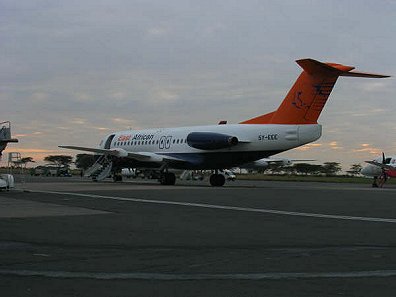 |
||
| An East African Safari Fokker F28-4000 (left and right) in 2003 - PHOTOs Daniel Amtmann | |||
|
Nairobi Eastleigh |
|||
|
Nairobi's Eastleigh Airport did little to enhance the city's status. In 1952 the Comets operated through Entebbe, perhaps as much because of Eastleigh's high elevation rather than its lack of suitable runways which could not easily be extended due to the fast expansion of the city's suburbs in the vacinity of the airport. Nevertheless the signpost at Eastleigh was well-known, and its modern counterpart at Embakasi never enjoyed the same fame. |
|||
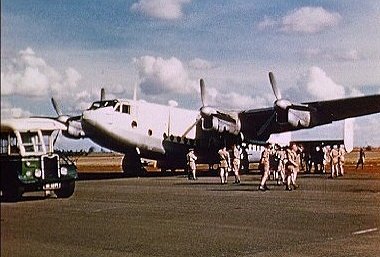 |
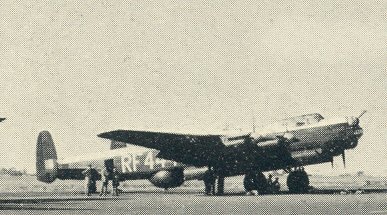 |
||
|
In the mid 50s, during what the Colonial Government termed the "Emergency", a Royal Air Force Avro York (left) arrives at Eastleigh with a contingent of British national servicemen while a Nairobi City Council bus waits to take them to barracks - PHOTO - from the British Empire in Colour. A Royal Air Force Avro Lincoln (right) at Eastleigh. The Lincoln was developed from the more famous Lancaster, from which the York was also developed - PHOTO - Public Relations Office for Kenya (Colonial Government). |
|||
|
|
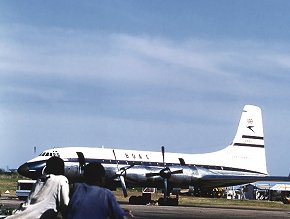 |
||
| BOAC Britannia 102 G-ANBC on a proving flight in 1957 poses by the famous sign (left ) - PHOTO - Bristol Aircraft Ltd. A rare photograph (right) by Ron Bullock of BOAC Britannia 102 G-ANBH on another proving flight which probably had something to do with the tail fin - compare the irregular white leading edge with that of BC. Several Britannias flew with this odd looking tail fin livery prior to entering service. Britannias never operated out of Eastleigh with fare paying passengers. | |||
|
|
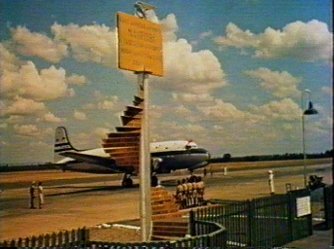 |
||
|
BOAC Argonaut Flight BA 161 arriving Nairobi Eastleigh around 1954. PHOTOs - J Arthur Rank Organisation - Film "Simba" Note the ensigns flying above the flight-deck window - an old BOAC tradition that was maintained until the mid-fifties |
|||
|
|
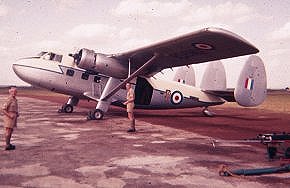 |
||
| USAF C47B (left) and RAF Scottish Aviation Twin Pioneer (right) during an Air Day in 1961. PHOTOs Malcolm McCrow | |||
|
|
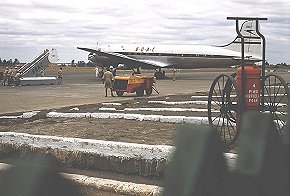 |
||
| While Eastleigh was the RAF Station for East Africa, the Air Force had to operate its jet. fighters and V- bombers from Embakasi Airport. More mundane flights did however operate out of RAF Eastleigh. RAF Avro Shackleton Mk 2 (left) at RAF Eastleigh during the same open day. An earlier view of Eastleigh (right) in 1955 with a superb array of airport clutter including the PWD (Public Works Department) foam fire extinguisher. The aircraft is BOAC's Argonaut G-ALHC on flight BA 161 which has just arrived from London, Rome, Cairo, Khartoum and Entebbe. After the Suez Crisis in 1956 the service routed through Benghazi in stead of Cairo. Benghazi had a dirt runway illuminated by kerosene flares. PHOTO (left) Malcolm McCrow and (right) Ron Bullock | |||
|
|
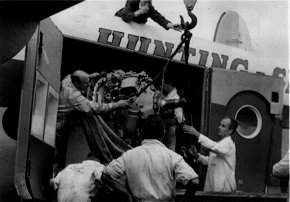 |
||
|
Rare photographs of prototype Britannia 312 at Eastleigh while Embakasi was still under construction. This series of photographs, taken by Roger Carman, show the Number 2 Bristol Proteus turboprop engine being changed. |
|||
|
|
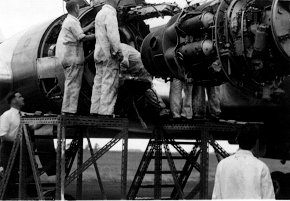 |
||
| The prototype Bristol Britannia 312 was undergoing high temperature high altitude take-offs, landings and tropical flight trials out of Eastleigh; it was grounded at Eastleigh because it had been flown through a tropical thunder/hail storm and suffered very significant damage. The leading edges of all the flying surfaces, and the propellers, looked as if they had been attacked by someone with a ballpein hammer. The radome was reduced to a kind of papier-mache. The worst problem, however, was the fact that hailstones had entered the engines, and in one case had so damaged the compressor in one of the four turbo-prop engines, that it had to be replaced. Unfortunately Roger couldn't get close enough to get details of the dented wing leading edges. | |||
|
|
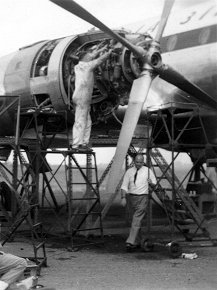 |
||
| This was to become a common scene at Embakasi and Entebbe after the introduction of the Britannias (both the 102 and 312) which were, initially, notorious for engine trouble and consequent bad time-keeping. As ever, the faithful Avro York - in this case belonging to Hunting Clan - was used to fly the replacement engine out from the UK. PHOTOs Roger Carman | |||
|
|
The de Havilland Dove which was the
personal transport of Emperor Haile Selassie. PHOTO - Paul Jackson
|
||
|
Nairobi West - Wilson Airport |
|||
|
|
|||
| Nairobi West was to become Wilson Airport on 25 January 1962 as a tribute to Mrs Florence K Wilson, a pioneer of civil aviation in Kenya. The aircraft in the centre of the photograph is a Cessna 150. PHOTO - Ron Leese | |||
| East Africa 50 years Ago | |||


